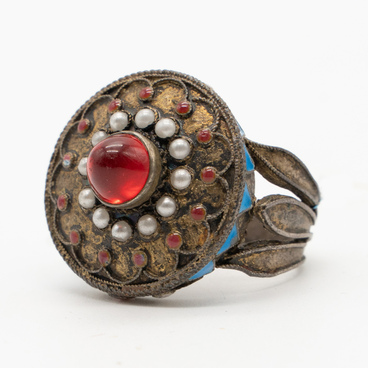In the study of the Chaliapin Estate on Novinsky Boulevard is a watercolor landscape called “Early Spring” by Count Vladimir Leonidovich Muravyov, a Russian landscape artist mostly unknown to today’s general public, whose main subject matter was hunting.
Vladimir Muravyov was born in May of 1861 in St. Petersburg, to a family of heraldmaster Leonid Mikhailovich Muravyov and Sofia Nikolayevna Orzhitskaya. Until 1881, he studied in the Page Corps, then attended the landscape class of Mikhail Konstantinovich Klodt at the Imperial Academy of the Arts in St. Petersburg.
Muravyov did not receive professional artistic education, which didn’t stop him from becoming one of the most fashionable landscape painters of the early 19th century. He mostly painted animals. The names of most of his paintings speak for themselves: “The Capercaillie Sings”, “Goats on the Lake Shore”, “The Fox Hunting Mice”. The main character of “Early Spring” is nature, waking up after winter: the snow is melting, the ducks are swimming, and, although the sky is still gray, everything is filled with excitement for the coming sunshine and warm weather.
Vladimir liked painting the sunrise, overflows of light in the sky at sunset, the moonlit night. Most of his works have a theatrical feeling to the way they are composed. For example, in the presented landscape, the trunks and crowns of trees are akin to stage curtains and drapes, and the three birches in the center of the painting are as if characters on stage — picturesque and mysterious.
Muravyov’s paintings were bought by wealthy hunting enthusiasts. They appreciated the artist’s work for its life–like depictions of animals, fabulous skies and revealing the enlightened essence of nature. The artist was also known for his personal life. He married future theater actress Vera Feodorovna Komissarzhevskaya and soon became interested in her sister Nadezhda, whom he married in secret. Thinking back on her husband, Nadezhda Feodorovna said:
Vladimir Muravyov was born in May of 1861 in St. Petersburg, to a family of heraldmaster Leonid Mikhailovich Muravyov and Sofia Nikolayevna Orzhitskaya. Until 1881, he studied in the Page Corps, then attended the landscape class of Mikhail Konstantinovich Klodt at the Imperial Academy of the Arts in St. Petersburg.
Muravyov did not receive professional artistic education, which didn’t stop him from becoming one of the most fashionable landscape painters of the early 19th century. He mostly painted animals. The names of most of his paintings speak for themselves: “The Capercaillie Sings”, “Goats on the Lake Shore”, “The Fox Hunting Mice”. The main character of “Early Spring” is nature, waking up after winter: the snow is melting, the ducks are swimming, and, although the sky is still gray, everything is filled with excitement for the coming sunshine and warm weather.
Vladimir liked painting the sunrise, overflows of light in the sky at sunset, the moonlit night. Most of his works have a theatrical feeling to the way they are composed. For example, in the presented landscape, the trunks and crowns of trees are akin to stage curtains and drapes, and the three birches in the center of the painting are as if characters on stage — picturesque and mysterious.
Muravyov’s paintings were bought by wealthy hunting enthusiasts. They appreciated the artist’s work for its life–like depictions of animals, fabulous skies and revealing the enlightened essence of nature. The artist was also known for his personal life. He married future theater actress Vera Feodorovna Komissarzhevskaya and soon became interested in her sister Nadezhda, whom he married in secret. Thinking back on her husband, Nadezhda Feodorovna said:



